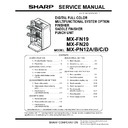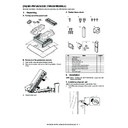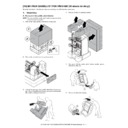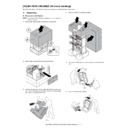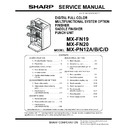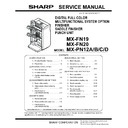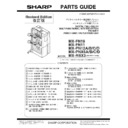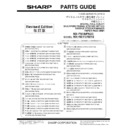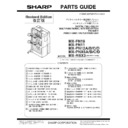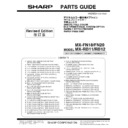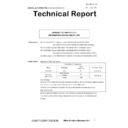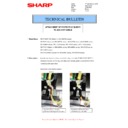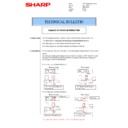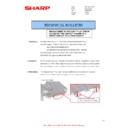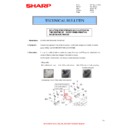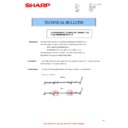Sharp MX-FN19 / MX-FN20 / MX-PN12 Service Manual / Specification ▷ View online
MX-FN19 OPERATIONAL DESCRIPTION 6 – 26
B. Checking for a jam in saddle stitch unit
The saddle stitch unit identifies any of the following conditions as a jam, and sends the jam signal to the host machine. In response, the host
machine may stop copying operation and indicate the presence of a jam on its control panel.
When all the doors are closed after the user has removed the jam, the saddle stitch unit checks whether the vertical path paper sensor
(FSVPPD) has detected the presence of paper. If the sensor has detected paper, the unit will identify the condition as being faulty jam removal
and send the jam signal to the host machine once again.
machine may stop copying operation and indicate the presence of a jam on its control panel.
When all the doors are closed after the user has removed the jam, the saddle stitch unit checks whether the vertical path paper sensor
(FSVPPD) has detected the presence of paper. If the sensor has detected paper, the unit will identify the condition as being faulty jam removal
and send the jam signal to the host machine once again.
FSPIND
FS1PD
FS2PD
FS3PD
FSVPPD
FSPDD
FSPPPD
FSLGTD
FSLGHPD
No.
Name of sensor
FSPDD
Delivery sensor
FSVPPD
Vertical path paper sensor
FS1PD
No.1 paper sensor
FS2PD
No.2 paper sensor
FS3PD
No.3 paper sensor
FSPIND
Saddle inlet sensor
Jam type
Sensor
Jam condition
Code
Inlet delay
FSPIND
The saddle inlet sensor (FSPIND) does not detect paper sheet even if
predetermined time (distance) has passed after receiving saddle delivery request
signal from the finisher.
predetermined time (distance) has passed after receiving saddle delivery request
signal from the finisher.
1793
Inlet stationary
FSPIND
The sheet does not move past from the saddle inlet sensor (FSPIND) even if
predetermined number of sheets have been delivered by the feeder motor (FSFM)
after the saddle inlet sensor (FSPIND) detects the top edge of sheet.
predetermined number of sheets have been delivered by the feeder motor (FSFM)
after the saddle inlet sensor (FSPIND) detects the top edge of sheet.
17A3
Feed delay
FS1PD
The NO.1 paper sensor (FS1PD) does not detect paper sheet even if
predetermined time (distance) has passed after the saddle inlet sensor (FSPIND)
detects the top edge of sheet.
predetermined time (distance) has passed after the saddle inlet sensor (FSPIND)
detects the top edge of sheet.
1791
Feed stationary
FS1PD, FS2PD, FS3PD
The sheet does not move past from the No.1 paper sensor (FS1PD), No.2 paper
sensor (FS2PD), and the No.3 paper sensor (FS3PD) even if predetermined
number of sheets have been delivered by the feed motor (FSFM) after the
No.1paper sensor (FS1PD) detects the top edge of sheet.
sensor (FS2PD), and the No.3 paper sensor (FS3PD) even if predetermined
number of sheets have been delivered by the feed motor (FSFM) after the
No.1paper sensor (FS1PD) detects the top edge of sheet.
17A1
Delivery delay
FSPDD
The paper sensor (FSPDD) does not detect paper even if predetermined number of
sheet stacks have been delivered by the paper folding motor (FSFOM) after paper
is pushed by the paper pushing plate.
sheet stacks have been delivered by the paper folding motor (FSFOM) after paper
is pushed by the paper pushing plate.
1792
Delivery stationary
FSPDD, FSVPPD
The paper stack does not move past from the delivery sensor (FSPDD) even if
predetermined number of stacks have been delivered by the paper folding motor
(FSFOM) after the delivery sensor (FSPDD) detects the top edge of sheet. The
paper stack does not move past from the vertical path paper sensor (FSVPPD)
even if predetermined number of stacks have been delivered by the paper folding
motor (FSFOM) after the delivery sensor (FSPDD) detects the stacks.
predetermined number of stacks have been delivered by the paper folding motor
(FSFOM) after the delivery sensor (FSPDD) detects the top edge of sheet. The
paper stack does not move past from the vertical path paper sensor (FSVPPD)
even if predetermined number of stacks have been delivered by the paper folding
motor (FSFOM) after the delivery sensor (FSPDD) detects the stacks.
17A2
Stitcher stapler
FSSHP2, FSSHP1
When the stitcher motor (FSFSTM/FSRSTM) is rotating clockwise, the stitcher
home position sensor (FSSHP2/FSSHP1) does not turn ON within 0.4 secs after it
has turned OFF. In addition, the sensor turns ON within 0.4 secs after the motor
has been rotated counterclockwise.
home position sensor (FSSHP2/FSSHP1) does not turn ON within 0.4 secs after it
has turned OFF. In addition, the sensor turns ON within 0.4 secs after the motor
has been rotated counterclockwise.
1786
Power-On
FSPPPD, FSPDD,
FSVPPD, FS1PD,
FS2PD, FS3PD, FSPIND
FSVPPD, FS1PD,
FS2PD, FS3PD, FSPIND
One of the sensors on the paper sensor PCB (No.1 paper sensor (FS1PD), No.2
paper sensor (FS2PD), No.3 paper sensor (FS3PD), vertical path paper sensor
(FSVPPD), delivery sensor (FSPDD), paper positioning plate paper sensor
(FSPPPD), saddle inlet sensor (FSPIND) detects a sheet when power is supplied.
paper sensor (FS2PD), No.3 paper sensor (FS3PD), vertical path paper sensor
(FSVPPD), delivery sensor (FSPDD), paper positioning plate paper sensor
(FSPPPD), saddle inlet sensor (FSPIND) detects a sheet when power is supplied.
1787
Door open
FSINDD, FFDD
The inlet cover sensor (FSINDD) detects opening of the cover during operation.
The front cover open/close sensor (FFDD) detects opening of the cover while paper
is on the stapling tray.
The front cover open/close sensor (FFDD) detects opening of the cover while paper
is on the stapling tray.
1788
MX-FN19 OPERATIONAL DESCRIPTION 6 – 27
C. Checking for a jam in punch module (MX-PN12A/B/C/D)
The finisher judges to be jammed, and sends the jam signal to the host machine when the conditions shown below occur. Then, the host
machine may stop copy operation, as well as displays paper jam sign.
machine may stop copy operation, as well as displays paper jam sign.
Jam type
Sensor
Jam condition
Code
iRC3100/3170/
2570
iR4570/
3570,2570/
2270
Feed delay
LED5, PTR5
The trailing edge sensor (LED5, PTR5) does not detect paper even if the specified time
(distance) has passed after delivery signal is received from the host machine.
(distance) has passed after delivery signal is received from the host machine.
1002
1012
Feed residence
LED5, PTR5
The sheet does not come through the trailing edge sensor (LED5, PTR5) even if the
specified time (distance) has passed after the trailing edge sensor (LED, PTR5)
detects paper.
specified time (distance) has passed after the trailing edge sensor (LED, PTR5)
detects paper.
1102
1122
Punch
FPHPD
The sensor does not turn ON again even if the specified time has passed after the
punch home position sensor (FPHPD) turns off.
punch home position sensor (FPHPD) turns off.
1644
1644
Power ON
LED5, PTR5
The sheet is detected by the trailing edge sensor (LED, 5, PTR5) after power is
supplied.
supplied.
1645
1645
MX-FN19 OPERATIONAL DESCRIPTION 6 – 28
8. Power supply system
A. Power supply route in finisher
The finisher controller PCB is supplied with two power supply sys-
tems, 13 VDC and 24 VDC, when the host machine is turned on.
The 24 VDC power supply system is intended for drive of the
motors and solenoids. As for the 13 VDC power supply system,
after the power is converted to 5 VDC by the regulator IC (IC28) on
the finisher controller PCB, it is used for drive of the sensors. After
it is converted to 3.3 VDC by the regulator IC(IC7) on the finisher
controller PCB, it is used for drive of the IC in the PCB. Power from
the power supply systems is supplied to the saddle stitcher control-
ler PCB from the finisher controller PCB.
The power is also supplied from the finisher controller PCB to the
saddle stitch controller PCB. In addition, it is also supplied to the
punch controller PCB when the optional punch module is mounted.
Some of the 24 VDC power used to drive motors is cut off when the
front/cover close detector switch (FFDD) is open. Figure shown
below is a block diagram showing the power supply system.
tems, 13 VDC and 24 VDC, when the host machine is turned on.
The 24 VDC power supply system is intended for drive of the
motors and solenoids. As for the 13 VDC power supply system,
after the power is converted to 5 VDC by the regulator IC (IC28) on
the finisher controller PCB, it is used for drive of the sensors. After
it is converted to 3.3 VDC by the regulator IC(IC7) on the finisher
controller PCB, it is used for drive of the IC in the PCB. Power from
the power supply systems is supplied to the saddle stitcher control-
ler PCB from the finisher controller PCB.
The power is also supplied from the finisher controller PCB to the
saddle stitch controller PCB. In addition, it is also supplied to the
punch controller PCB when the optional punch module is mounted.
Some of the 24 VDC power used to drive motors is cut off when the
front/cover close detector switch (FFDD) is open. Figure shown
below is a block diagram showing the power supply system.
B. Protect functions of finisher
The 24 VDC power line used to drive motors and solenoids is
equipped with a fuse or motor driver having overcurrent protector.
equipped with a fuse or motor driver having overcurrent protector.
C. Power supply route in saddle stitcher
When the host machine power switch is turned ON while the door
is closed, 24VDC and 13VDC power lines are supplied by the fin-
isher controller PCB.
The 24VDC power is used to drive of both the motors and sole-
noids. The 24V power to solenoids is supplied from the finisher
controller PCB without passing through any protective mechanisms
(microswitches, or the like).
The 24V power to motors, on the other hand, will not be supplied if
any of the three door switches is open.
As for the 13 VDC power supply system, after the power is con-
verted to 5 VDC by the regulator IC (IC512) on the stitcher control-
ler PCB, it is used for drive of the sensor. After it is converted to 3.3
VDC by the regulator IC (IC10) in the saddle stitcher controller
PCB, it is used for drive of the IC in the PCB.
is closed, 24VDC and 13VDC power lines are supplied by the fin-
isher controller PCB.
The 24VDC power is used to drive of both the motors and sole-
noids. The 24V power to solenoids is supplied from the finisher
controller PCB without passing through any protective mechanisms
(microswitches, or the like).
The 24V power to motors, on the other hand, will not be supplied if
any of the three door switches is open.
As for the 13 VDC power supply system, after the power is con-
verted to 5 VDC by the regulator IC (IC512) on the stitcher control-
ler PCB, it is used for drive of the sensor. After it is converted to 3.3
VDC by the regulator IC (IC10) in the saddle stitcher controller
PCB, it is used for drive of the IC in the PCB.
D. Protect functions of saddle stitcher
The 24 VDC power supply used for motors and solenoids is
equipped with a circuit breaker (CB1). The 24V power supply used
to drive the guide motor (FSGM), alignment motor (FSJM), and the
paper positioning plate motor (FPPM) is equipped with a fuse
designed to blow when an overcurrent flows.
equipped with a circuit breaker (CB1). The 24V power supply used
to drive the guide motor (FSGM), alignment motor (FSJM), and the
paper positioning plate motor (FPPM) is equipped with a fuse
designed to blow when an overcurrent flows.
E. Punch module (option)
(1) Outline
When the host machine is turned on, the punch module is supplied
by the finisher control PCB with 24-V and 5-V power.
The 24-V power is used to drive the motors, while the 5-V power is
used by sensors and the ICs on the punch control PCB.
The 24-V power to the motors will be cut off when the joint switch of
the finisher is open. The following is a block diagram for the power
supply system.
by the finisher control PCB with 24-V and 5-V power.
The 24-V power is used to drive the motors, while the 5-V power is
used by sensors and the ICs on the punch control PCB.
The 24-V power to the motors will be cut off when the joint switch of
the finisher is open. The following is a block diagram for the power
supply system.
(2) Protective mechanisms
The 24-V system used to drive the punch motor is equipped with a
built-in fuse that melts in the presence of overcurrent.
built-in fuse that melts in the presence of overcurrent.
Front cover close
detection switch (FFDD)
Saddle stitcher
controller PCB
Finisher controller PCB
Host
machine
Motor
Motor
Solenoids
Sensor
system
Logic
system
Regulator IC
Regulator IC
(IC28)
(IC7)
Punch controller PCB
(Punch module (optional))
Front cover close
detection switch (FFDD)
Finisher
controller
PCB
Circuit
breaker
(FU3)
Regulator IC
Regulator IC
Logic
system
Sensor system
Motor system
Motor system
Motor system
Solenoid system
Saddle stitcher controller PCB
Inlet door
switch (FSINDSW)
Finisher
control
PCB
Upper door
switch
(FPUDSW)
Front door
switch
(FPFDD)
Punch control PCB
Motor system
Motor system
LED PCB
Sensor system
Logic system
No part of this publication may be reproduced,
stored in a retrieval system, or transmitted in
any form or by any means, electronic, mechanical,
photocopying, recording, or otherwise, without
prior written permission of the publisher.
stored in a retrieval system, or transmitted in
any form or by any means, electronic, mechanical,
photocopying, recording, or otherwise, without
prior written permission of the publisher.
COPYRIGHT
©
XXXX BYSHARP CORPORATION
ALL RIGHTS RESERVED.
The PWB’s of this model employs lead-free solder. The “LF” marks indicated on the PWB’s and the Service Manual mean “Lead-Free” solder.
LEAD-FREE SOLDER
The alphabet following the LF mark shows the kind of lead-free solder.
(1) NOTE FOR THE USE OF LEAD-FREE SOLDER THREAD
When repairing a lead-free solder PWB, use lead-free solder thread.
Never use conventional lead solder thread, which may cause a breakdown or an accident.
Since the melting-point of lead-free solder thread is about 40°C higher than that of conventional lead solder thread, the use of the
Never use conventional lead solder thread, which may cause a breakdown or an accident.
Since the melting-point of lead-free solder thread is about 40°C higher than that of conventional lead solder thread, the use of the
exclusive-use soldering iron is recommended.
(2) NOTE FOR SOLDERING WORK
Since the melting-point of lead-free solder is about 220°C, which is about 40°C higher than that of conventional lead solder, and its soldering
capacity is inferior to conventional one, it is apt to keep the soldering iron in contact with the PWB for longer time. This may cause land
separation or may exceed the heat-resistive temperature of components. Use enough care to separate the soldering iron from the PWB when
completion of soldering is confirmed.
Since lead-free solder includes a greater quantity of tin, the iron tip may corrode easily. Turn ON/OFF the soldering iron power frequently.
If different-kind solder remains on the soldering iron tip, it is melted together with lead-free solder. To avoid this, clean the soldering iron
Since lead-free solder includes a greater quantity of tin, the iron tip may corrode easily. Turn ON/OFF the soldering iron power frequently.
If different-kind solder remains on the soldering iron tip, it is melted together with lead-free solder. To avoid this, clean the soldering iron
tip after completion of soldering work.
If the soldering iron tip is discolored black during soldering work, clean and file the tip with steel wool or a fine filer.
If the soldering iron tip is discolored black during soldering work, clean and file the tip with steel wool or a fine filer.
Example:
5mm
Lead-Free
Solder composition
code (Refer to the
table at the right.)
<Solder composition code of lead-free solder>
Solder composition
Sn-Ag-Cu
Sn-Ag-Bi
Sn-Ag-Bi-Cu
Sn-Zn-Bi
Sn-In-Ag-Bi
Sn-Cu-Ni
Sn-Ag-Sb
Bi-Sn-Ag-P
Bi-Sn-Ag
Sn-Ag-Bi
Sn-Ag-Bi-Cu
Sn-Zn-Bi
Sn-In-Ag-Bi
Sn-Cu-Ni
Sn-Ag-Sb
Bi-Sn-Ag-P
Bi-Sn-Ag
a
b
z
i
n
s
s
p
Solder composition code
a

